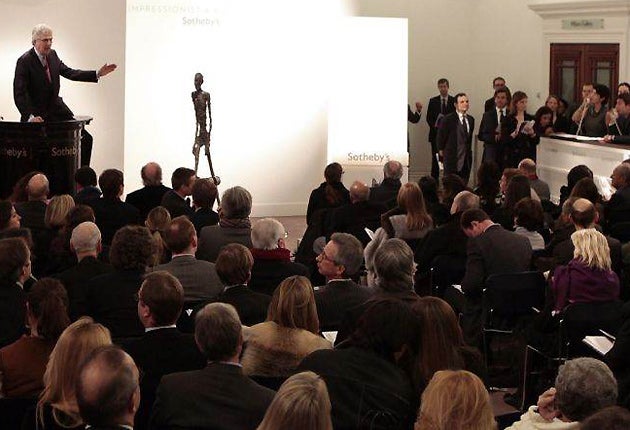£4.7m - the average auction lot as art bounces back

The turning point that Britain’s ailing art market had been praying for seems to have arrived, at long last.
Following the incredible £65m sale of a Giacometti sculpture that set a new world record at Sotheby’s auction house this week by becoming the most expensive work of art every sold at auction in a space of eight minutes, analysts say the market has got its mojo back.
This week’s series of sales, seen by many as a weather-vane of the state of the art market, have started with a bang. There had been some anxiety over the lack of sellers coming forward with high quality paintings and masterpieces, in the recession.
But today, Sotheby’s said its average lot in their Impressionist and Modern art sale last night was £4,736,398 - the highest ever for a London sale. It included Rene Magritte’s Le Beau Navire - one of the finest 1940s nudes ever to have appeared on the market which had been in the same private collection since 1977 - which fetched a healthy £3.7m, exceeding its upper estimated price.
Christie’s this week reported that Picasso’s Tete de Femme (Jacqueline) sold for £8.1m - more than double its highest estimate of £4m, while four of its other works sold for over £5m. The results, said Giovanna Bertazzoni, the head of the auction house’s Impressionist and Modern art, showed that “demand is high” and that they could now “feed the appetite of these buyers by offering a greate supply than in recent months.”
This could not have been said a few months ago; 2009 was the year the art market bubble finally burst – prices plunged, sellers got scared and the number of paintings up for auction dwindled dramatically. Until recently, auction houses were desperate for a supply of high quality works of art to sell, but few collectors were willing to let go of their Picas
sos, or Cezannes, or Matisses, at a time when the banking economy was collapsing, for fear of losing the their liquid assets.
Now, the sellers appear to be back, and experts see clear signs of recovery, although few can predict if auction houses will ever emulate the inflated prices of 2007 and ‘08.
Georgina Adam, market editor at The Arts Newspaper said she had discerned a distinct upturn. “I don’t think the bust has turned to boom but I do think there’s been a recovery. Sellers are coming back if you look at sales. This time last year, people didn’t know how much they were worth but they now have a better idea of it,” she said.
But Ms Adam added that prices were still down when compared to 2008, and that some collectors were also “distress selling”.
Sotheby’s – which sold just three paintings for over £10m last year – has placed an estimated value of more than £10m for three works in their sales of contemporary, Impressionist and Modern works, this week.
The auction house said it had seen the number of works for sale rise dramatically: in February 2008, there were 70 lots in the evenings contemporary sales, which last year shrunk to 27 for the same sales. This year, they have risen to 80 lots.
Returning market confidence came after the success of last November’s sales, in which Sotheby’s sold Andy Warhol’s 200 One Dollar Bills for $43.7m – three times its highest estimate which was $12m. The bidding started at $6m with the second bid raised dramatically to $12m.
Christie’s too has seen buyers more than double: in last year’s February sales of Impressionist and Modern works, they had 30 lots to sell; this time round they have 86 lots.
Last November’s sales for both auction houses saw a 70 percent sell-through rate – 70 percent of all items on offer were sold – which gave those buying and those selling greater confidence for this year’s sales.
Both auction houses agree there was too little supply, too much demand in the market, with not enough masterpieces coming though. The ones that were put on the market were pounced upon instantly.
Helena Newman, from Sotheby’s said “What we saw last year was extraordinary demand for great quality masterpieces. The challenge was supplying for the demand.”
Sellers were unwilling to consign their best paintings in such an unstable climate, because they did not want to put their earned money in the bank at a time when several were collapsing.
Join our commenting forum
Join thought-provoking conversations, follow other Independent readers and see their replies
Comments
Bookmark popover
Removed from bookmarks